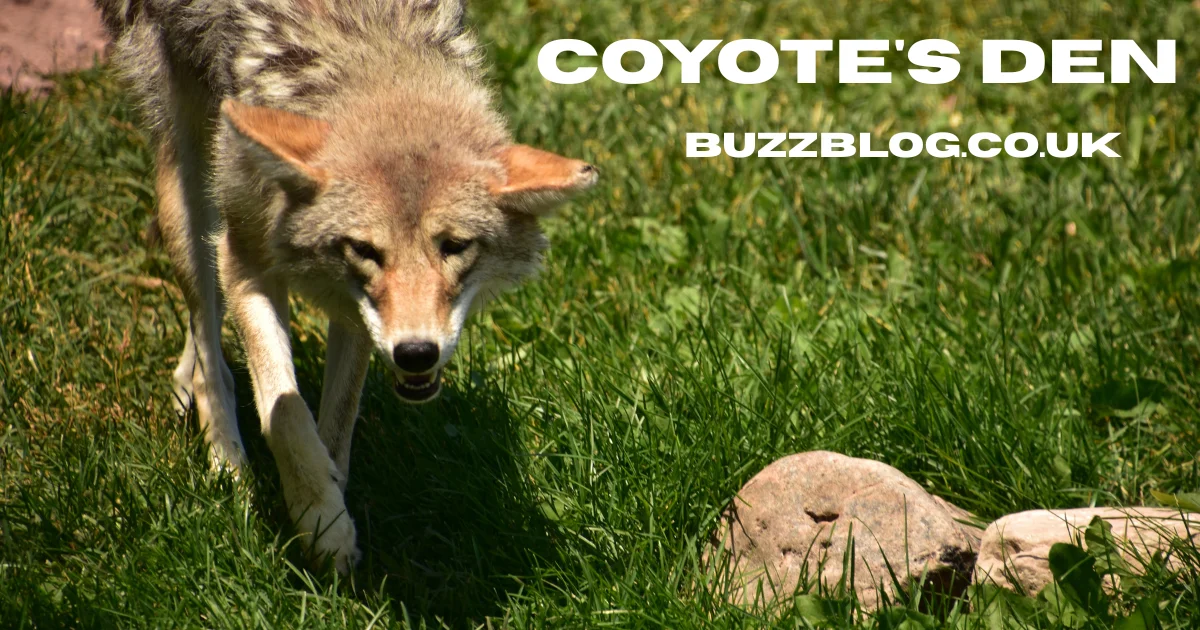Introduction
Coyotes are often seen as clever survivors, adaptable to almost any environment. But behind their wild, free-roaming image lies a hidden world—beneath the ground. This is the coyote den, a safe haven where life begins, nurtured, and fiercely protected. Understanding how coyotes build and use their dens offers a glimpse into their intelligence, instincts, and family life.
Understanding the Coyote
Coyotes (Canis latrans) are among the most adaptable mammals in North America. Whether in the deserts of Arizona, the forests of Canada, or the suburbs of Los Angeles, coyotes thrive. Their adaptability isn’t just about hunting or scavenging—it’s about how they create shelter and raise their young in constantly changing environments.
The Purpose of a Den
For coyotes, a den isn’t just a home—it’s a fortress and a nursery combined. Dens serve two main purposes:
- Protection: They provide safety from predators and harsh weather.
- Breeding: Female coyotes (known as bitches) give birth and nurse their pups inside these dens, ensuring warmth and security during their most vulnerable stages.
Choosing the Right Location
Coyotes are picky when it comes to selecting their den site. They prefer quiet, concealed areas with minimal human disturbance—think thick vegetation, brushy slopes, or rocky hillsides. They also look for elevated spots to get a better view of the surroundings while staying hidden from potential threats. Proximity to water and abundant prey is another deciding factor.
Types of Coyote Dens
Not all dens are dug from scratch. Coyotes are resourceful creatures and will use:
- Abandoned burrows from badgers, foxes, or groundhogs.
- Rock crevices or hollow logs as natural shelters.
- Occasionally, man-made structures like culverts or old sheds.
The adaptability of coyotes allows them to convert almost any hidden space into a protective den.
How Coyotes Build Their Dens
Building a den is a shared effort. The female usually selects the site, while both parents may take part in digging. The process can take several days and results in a tunnel that stretches up to 10 to 15 feet long, ending in a cozy nesting chamber. Sometimes, coyotes enlarge old burrows rather than start from scratch—saving time and energy.
Den Structure and Layout
A typical coyote den has:
- One main entrance, often facing south to catch the sun.
- A main chamber for sleeping and nursing.
- Multiple escape tunnels for quick exits if danger appears.
Inside, the den is lined with soft materials like leaves, grass, or fur to provide warmth for the pups.
Breeding Season and Den Use
Coyotes breed once a year, typically between January and March. After a 60–63 day gestation period, the female retreats to the den to give birth, usually in April or May. During this time, the male becomes the provider, hunting and guarding the area while the female stays with the newborns.
Pups in the Den
Coyote pups are born blind, deaf, and helpless, weighing just a few hundred grams. The den becomes their entire world for the first few weeks. The mother nurses them, while the father brings food and stands guard nearby. Around three weeks old, the pups start to explore outside under the watchful eyes of their parents.
Protection Strategies
Coyotes are highly protective parents. If threatened, they’ll use distraction techniques, such as pretending to be injured to lure predators away from the den. They may also relocate their pups to a secondary den if they sense danger. Vocal warnings, growls, and yips serve as communication signals between family members.
Predators and Threats
While coyotes are skilled survivors, their dens can be vulnerable to predators such as bears, wolves, or large birds of prey. Human activities—like land development and trapping—also pose major threats. Still, their den-building instincts and relocation strategies give them an edge in survival.
When Pups Leave the Den
At around 6 to 8 weeks old, the pups start spending more time outside. By three months, they abandon the den entirely and begin learning hunting skills from their parents. By late summer, most young coyotes disperse to find their own territories.
Seasonal Use of Dens
Coyotes don’t live in their dens year-round. They use them mainly during the breeding and pup-rearing seasons. Once the pups are mature, the dens are abandoned but often reused the next year—either by the same pair or by other wildlife.
Human Encounters and Coexistence
Finding a coyote den can be intriguing but approaching it is never a good idea. Coyotes may perceive humans as threats and react defensively. If you suspect a den near your property, it’s best to keep pets indoors and avoid the area. Coexistence begins with respect for wildlife spaces.
Conclusion
Coyote den are more than just holes in the ground—they’re the foundation of survival, nurturing, and family for one of North America’s most resilient animals. From selecting the perfect spot to fiercely guarding their pups, coyotes show intelligence, adaptability, and care that rival many other species. The more we understand their denning behavior, the more we can appreciate the intricate balance of nature they help maintain.

